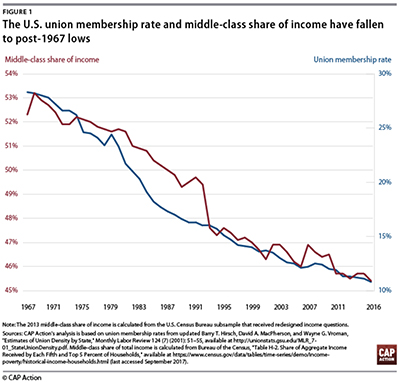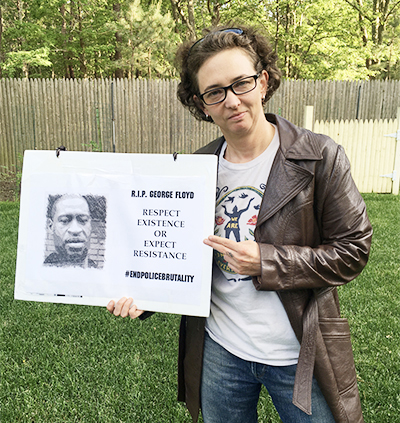Kerry Spooner
Editor's note: Kerry Spooner, Ph.D., adjunct assistant professor of English, is a new writer for The WORD starting this semester. Contact Kerry with questions or feedback about this article. I originally wrote this article in late February. Since this is my first semester as a contributor to The WORD, I was eager to introduce myself to all of you. In that draft, I had shared my "union moment" and encouraged all adjuncts to stand in solidarity with the FA by becoming or remaining dues-paying members. Then the Covid-19 pandemic happened. Then the protests. It would be completely tone deaf to have submitted my original draft for this column. As an adjunct and diehard unionist, I could not in good conscience fail to address how the pandemic and the protests impact us as academic unionists. Thus I share a very different column below because Covid-19 and the protests have taught us that there is a real need for a comprehensive national labor re-education campaign that spans years and rank-and-file driven unionism across all industries. The pandemic has exposed deep inequalitiesUnions are the most effective counterweight to profit-driven employer and legislative decisions. Financial solvency is important but cannot be the sole interest; equally important are job security, job benefits, safe and comfortable working conditions, living wage, work-life balance—this list could go on. Unions, we know, have a long history of demanding and creating more equitable economic and social change. Of course this work continues, especially now amid our national Covid-19 public health catastrophe. Many of us are fortunate to work from home, still receiving pay and likely safe. While writing this article, a conservative estimate has over 30 million people unemployed, safe at home perhaps, but with no guarantee of returning to work. And then there are those who work in unreported employment, unable to receive unemployment compensation and likely food and housing insecure. Similarly contingent, gig and part-time workers often are housing and food insecure. These challenges have been worsened by the pandemic. Another tragedy is the exploitation of wage-dependent workers whose lives are assumed sacrificial. Their options? Work and risk infection and possibly death, or don’t get paid. This is a trick, disguised as free choice but really a form of coercive control. Essential workers are caught on the meridian between life-threatening working conditions and staying home with the risk that no income will further exacerbate hunger and homelessness. Workers at risk are women and people of color
|
"Nearly two-thirds of union members between ages 18 and 64 are women and/or people of color. Unions are especially beneficial to these workers, who often face challenges in the workplace such as discrimination and pay inequity." |
|
This is the result of four decades of an economic ideological shift bent on shredding our social contract and ending collective bargaining. Social determinants conditioned by 400 years of systemic racism and 40 years of neoliberal policies are more predictive of who will die from SARS-CoV-2/COVID-19.
The World Health Organization recognizes what large numbers of studies are revealing, i.e., that social determinants which are "the conditions in which people are born, grow, live, work and age […] are shaped by the distribution of money, power and resources at global, national and local levels." Covid-19 deaths are socially determined.
Therefore, had we a social contract intact that a robust national union would have maintained, many deaths could have been prevented. Zoë Carpenter, a contributing writer for The Nation, reminds readers of the present exigency: "these underlying inequities are reinforcing more immediate factors (such as the fact that Black and Hispanic workers are less likely to be able to stay home) that increase exposure to the virus and limit access to care, including testing." We don’t have the luxury to wait.
Unions more critical than ever but affiliation rates are down
Currently, unions lack the establishment to broadly mobilize and organize alone. Consider the Economic Policy Institute report that 88% of essential workers have no union contract. Not surprisingly, the three industries that employ most workers (food and agriculture, health care and government and community-based services) have the lowest union coverage rate.
The Bureau of Labor Statistics’ Current Population Survey data on employment and union affiliation show the national coverage rate for all industries, both essential and nonessential, at 11.6%; the membership rate is slightly lower at 10.3%. This change is insignificant given the drastic decline in membership over the last 70 years. In 1950, over 1 in 3 private-sector workers were unionized. Today, 1 in 20 private-sector workers are unionized.
 |
|
Union membership rates in the U.S. correlate strongly with the decline of middle-class share of income. (chart from Center for American Progress) |
|
This significant reduction in unionized labor has had a devastating impact on all workers. The chart at right demonstrates a correlation between the decline in union membership and the decline in middle-class income across all workers.
Released by the Center for American Progress, the report, "The State of Unions in the Labor Market: Pre-July 2018 Jobs Day Release," also points out that "nearly two-thirds of union members between ages 18 and 64 are women and/or people of color. Unions are especially beneficial to these workers, who often face challenges in the workplace such as discrimination and pay inequity."
While union membership declined, structural racism has hardened. In "How the Decline of Unions Has Increased Racial Inequality," sociologists Meredith Kleykamp and Jake Rosenfeld observe that "[t]he near disappearance of private sector unions in recent times has made many of America’s economic and social problems worse—including racial wage gaps." Increased racial and ethnic disparities in accessing quality employment, housing, healthcare and education can be traced to the de-unionization caused by anti-union propaganda and legislation. The downward long-term trajectory must be turned around.
For the few essential workers lucky to be covered by a union today, they won premium pay, paid sick leave and PPE, just to name a few. On behalf of their 12.5 million members, the AFL-CIO issued a comprehensive list of recommendations for OSHA to implement. AFSCME is demanding federal, state and local aid for front-line public service workers.
The FA is doing the same. Our union, together with the Guild and AME, is actively fighting for safe workplace conditions, up-to-date safety policies, work-from-home provisions, supplies and equipment for SCCC employees. Perhaps I’m quixotic, but I imagine a union of unions in Suffolk County and an outline of our line in the sand and together we fight.
In addition to unions, the vast inequities laid bare from this pandemic have prompted collaboration among other worker rights organizations: People’s Strike!, Cooperation Jackson, Black Workers for Justice, The Red Nation, Center for Critical Thought and National Lawyers Guild, among others.
The demand to put people before profits is the collective sound of resistance.
The union is the solution
Addressing the trifecta of a pandemic, an economic breakdown and a government unwilling to help the vulnerable communities most impacted will require a potent national labor and social movement as well as elected officials to enact laws, create policies and establish regulations designed to lift all workers.
This won’t be easy. We need a comprehensive national labor re-education campaign that spans years and rank-and-file driven unionism across all industries.
Again, we don’t have the luxury to wait. The CDC estimates over 100,000 largely preventable deaths due to political malfeasance and social inequities. No human is sacrificial. Those working in essential services should have had a free choice to continue working without the threat of lost income.
Our nation cannot continue to coerce and sacrifice workers if we recognize each other as essential.
We must be advocating for more robust unions that are willing to band together around the never-more-urgent human rights issues workers are facing today.
